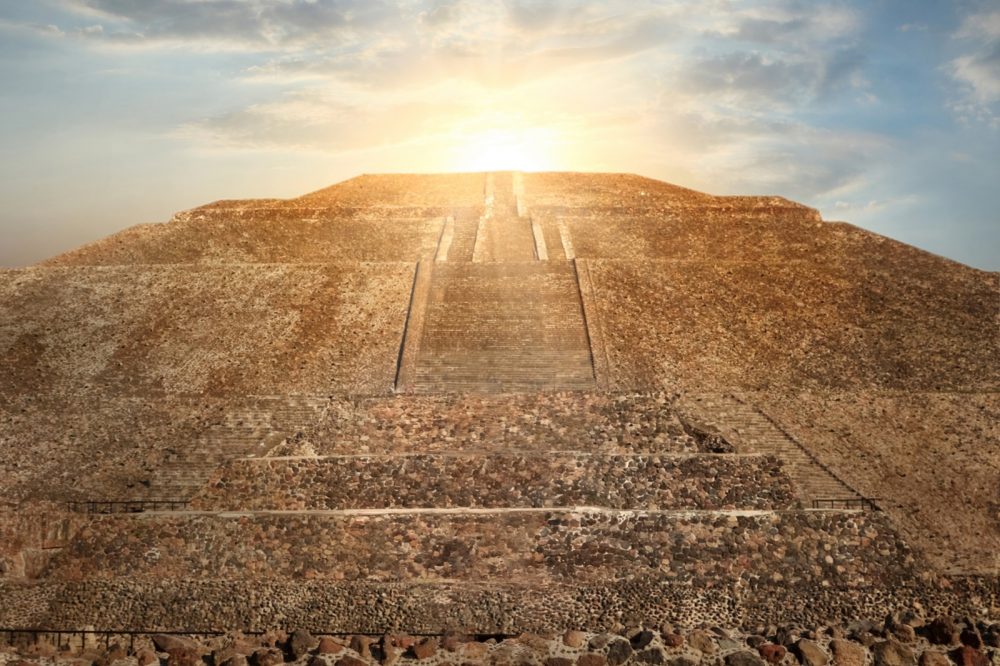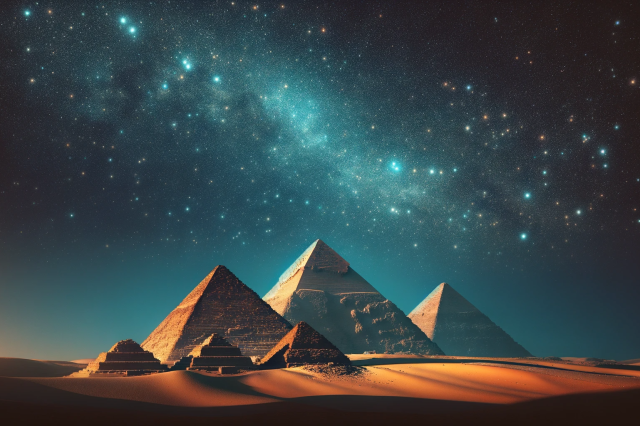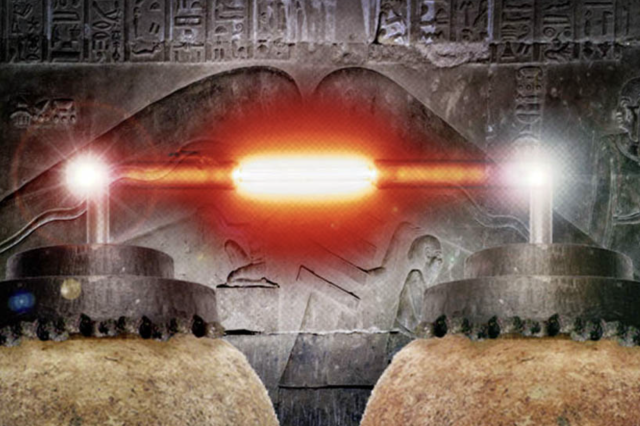Thousands of years ago a 'Mystery Culture' dug a massive network of tunnels, cavities, and chambers beneath the city of Teotihuacan. The exact purpose of this ancient underground system of tunnels and chambers continues to elude scholars.
There are thousands of pyramids scattered across the globe. Pyramids were erected on nearly all continents on Earth by different cultures throughout history. But many secrets about the pyramids remain hidden not inside but deep beneath their foundations.
The most famous pyramids are those built on the Giza Plateau, where the pyramids of Khafre, Menakure, and Khufu stand proudly, guarded by the mighty Sphinx. Although the most famous, they are certainly not the oldest nor largest pyramids built on the planet. The largest pyramid is the so-called Great Pyramid of Cholula, located in Puebla, Cholula, modern-day Mexico. Measuring 160,000 square meters, the Pyramid of Cholula has three times the 53,056.5 square meter base area of the Great Pyramid at Giza.

Having a total estimated volume of 4.45 million cubic meters, the Great Pyramid of Cholula was a pyramid that was worthy of the most impressive monuments in the world, even more, extensive than the great pyramid of Giza in Egypt, which contains approximately 2.5 million cubic meters.
But Cholula is one of the many pyramids on Earth, and there are other fine examples of pyramids buildings found in Mexico. Join me in this excerpt from my upcoming book, Pyramidomania – A World of Pyramids, as I explore the mysteries of Teotihuacan, its mysterious ancient pyramids, and the massive underground world beneath.
Teotihuacan and its underground world
One of the most important ancient cities constructed in pre-Columbian America was Teotihuacan. Once one of the world’s largest cities, inhabited by more than 150,000 people, the city of Teotihuacan is home to a mind-bending set of structures, and where an ancient culture shrouded in mystery built the most architecturally significant Mesoamerican Pyramids in pre-Columbian America. Teotihuacan was believed to be home to more than 2,000 labyrinthine housing complexes, including artisan workshops, markets, and temples.
Its mysterious ancient builders constructed a ceremonial center that could hold up to 40,000 people where different religious ceremonies were performed in honor of the god of the sun, the moon, the rain, and their most important deity, Quetzalcoatl, the plumed serpent. The city is home to some of the most impressive examples of ancient architecture in the world. Home to a massive central road dubbed the “Avenue of the Dead.”
When viewed from the air, it becomes clear that Teotihucan’s builders planned the city to the most minimalistic detail, resulting in a massive ancient metropolis covering 8 square miles. The entire city’s layout gave off an impression that its original builders, whoever they were, planned the city in an unprecedented way, which allowed the construction of a city worthy of gods.
But as impressive as the city is above the surface, it is equally stunning beneath the surface. There, beneath the massive pyramids that made Teotihuacan famous globally, are numerous cavities, chambers, and tunnels running for miles out. Beneath the foundations of the ancient city is a massively interconnected labyrinth.
Numerous underground tunnels exist underneath Teotihuacan’s pyramids. Researchers discovered hidden tunnels and cavities supposedly meant to illustrate the underworld inside them. Some of these tunnels were discovered thanks to an electrical resistivity study by researchers from the National Institute of Anthropology and History, joined by scientists from the National Autonomous University of Mexico (UNAM).
The underground tunnels, however, are not a discovery and certainly not a surprising one. The existence of a vast and mysterious underworld composed of caves and human-made tunnels beneath Teotihuacan and its pyramids is an untold secret known for centuries. Like the pyramids of Giza and their subterranean world, the tunnels, cavities, and chambers beneath Teotihuacan are said to connect the city’s most critical sections by underground networks.
One of the first documented cases of subterranean tunnels and chambers beneath Teotihuacan was recorded by the French explorer and anthropologist Desiré Charnay.

Charnay was one of the first Europeans to enter the vast labyrinth of tunnels in modern times and pen down a detailed account of it. In his 1880 book “Les anciennes villes du Nouveau Monde,” the French researcher recounts” being led by a local guide into strange cavernous quarries, located approximately two-and-a-half miles (around 1.6 kilometers) west of the Pyramid of the Moon at Teotihuacan.
The underground world of Teotihuacan is a big one. It is so big that geologists argue that some of the cavities beneath the ancient city may have originated millions of years ago due to the area’s intense volcanic activity, which created a natural network of lava tubes. The city builders knew of their existence and even expanded some cavities, turning them into large chambers. Smaller tunnels were ‘reconstructed,’ and the ancients developed them and removed millions of tons of volcanic rocks that were later used to build some of the buildings in Teotihuacan.
This feat alone is beyond impressive. The ancient city of Teotihuacan was built long before the Aztecs ruled Central Mexico. When the ancient Aztecs ‘re-discovered Teotihuacan, the city was already ancient and in ruins, covered by vegetation. This means that long before the Aztecs, the ancient Teotihuacan culture excavated millions of volcanic rock tons.
Revealing Teotihuacan’s secrets
During the 1950s-1960s, archaeologists Rene Millon and George L. Cowgill systematically mapped the city of Teotihuacán in the Valley of Mexico. Millon speculated that Teotihuacan’s largest pyramids were built beneath massive networks of subterranean chambers and cavities. Millon discovered traces of what seemed to be a massive blocked pit during excavations near the Pyramid of the Sun–the largest Pyramid at Teotihuacan.
Millon argued that the pit led toward a tomb of massive proportions. Despite his exciting find, in 1971, it was revealed that the pit leads not to the entrance to a massive tomb but into a vast ancient network of tunnels beneath the Pyramid.
Following a tunnel running beneath the pyramid for around 100 meters, just at the pyramid’s center were a series of ancient chambers. The archaeologists discovered traces of the tunnel being blocked off in ancient times. Nonetheless, the tunnels’ chambers yielded only smaller figures made of obsidian, pottery fragments, indicators that the tunnels and chambers may have been looted in antiquity.
Despite this, Teotihuacan had more to offer. Perhaps more than archaeologists thought possible.
Further studies
Comprehensive studies and examinations of the caves and chambers in the 1990s, led by UNAM researcher Linda Manzanilla concluded that the complex network of tunnels, cavities, and chambers beneath Teotihuacan was not lava tubes but human-made structures beneath the surface. Manzanilla argued that the chambers were probably used as subterranean qualities in ancient times, which were then reused for funerary and/or ritualistic purposes.
Archaeological excavations in 2006 revealed another of Teotihuacan’s ancient secrets. A group of experts found a nearly 60-foot vertical shaft beneath Teotihuacan’s Avenue of the Dead. Excavations revealed a fascinating network of tunnels and chambers. Inside, the archaeologists recovered human rains and many artifacts crafted from obsidian. The exact purpose of the tunnels and chambers beneath the avenue continues to elude experts.
In 2017, using electrical resistivity imaging, a group of scientists mapped the composition of the chambers beneath the Avenue of the Dead, revealing larger subterranean cavities and the presence of groundwater.
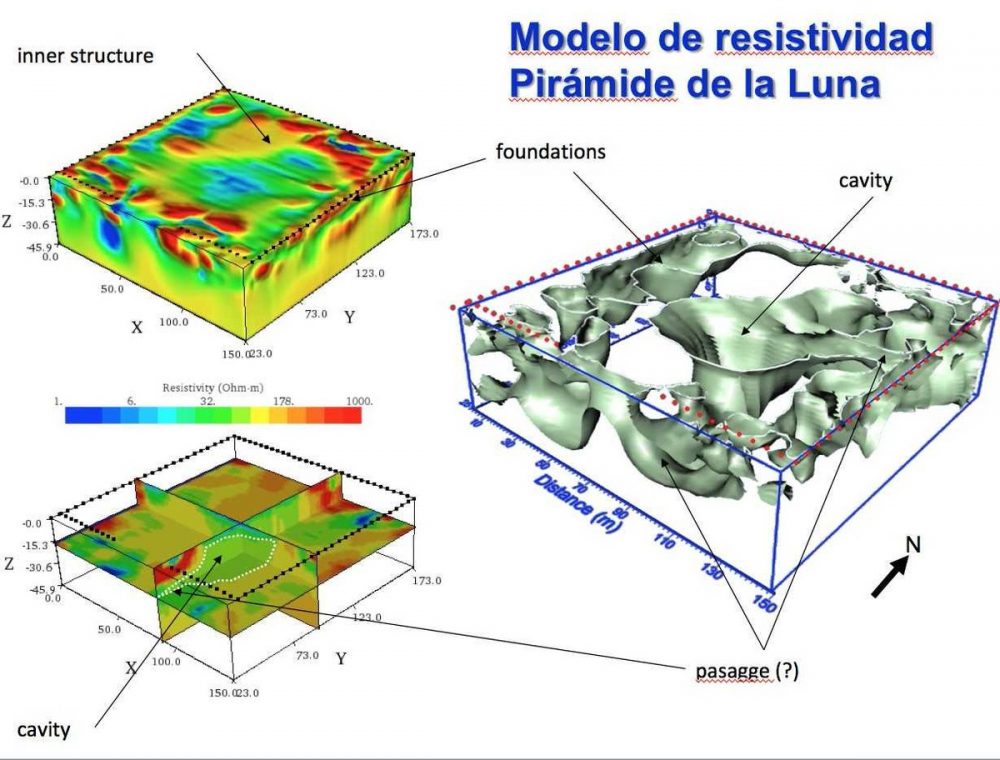
At a depth of around 26 feet, and starting at the center of the avenue, the scientists found there was a massive cavity at 49 feet, leading towards another larger chamber located beneath Teotihuacan’s Pyramid of the Moon. The more experts explored, the more fascinating details were revealed.
Although the tunnels’ age remains an enigma, the experts discovered that the excavated tunnels’ walls were decorated with pyrite. The tunnels’ walls were covered in pyrite powder, a mineral that reflects the light and shines in the dark. It is believed that this complex network of underground tunnels may have served in ancient times as a symbolic gateway connecting the ancient underground world with the sky. These tunnels were sealed off around 300 CE for reasons unknown.
Purpose
But what led the ancient builders of Teotihuacan to put such an effort into creating a massive subterranean world with extensive tunnels and chambers?
The effort is even more significant when you realize that they also built one of the largest ancient cities in antiquity, with massive temples, pyramids, plazas, housing units, and markets. For the ancient Teotihuacan culture, the underworld was essential to their belief system. Therefore, finding a massive underground complex beneath the city isn’t surprising. Teotihuacan was important, and its surface was reflected in the subterranean world.
Baffling discoveries; Teotihuacan and its underground tunnels
In 2003, archaeologists exploring the Pyramid of the Feathered Serpent discovered a tunnel spanning hundreds of meters beneath the structure. The opening was discovered by surprise by INAH archaeologist Sergio Gómez. As noted by the Smithsonian, in the fall of 2003, torrential rains swept through the ancient ruins of the “city of the Gods.”
The heavy rainfall would eventually reveal a massive sinkhole in the footsteps of the Pyramid. But little did Gómez know that the massive hole near the pyramid led to a secret kept for thousands of years. Not knowing where the sinkhole led, the archaeologist descended into the darkness. Once on the ground, he realized that he was standing in what appeared to be a massive, human-made tunnel. Although massive boulders sealed off both ends, the tunnel’s ceiling was visible.
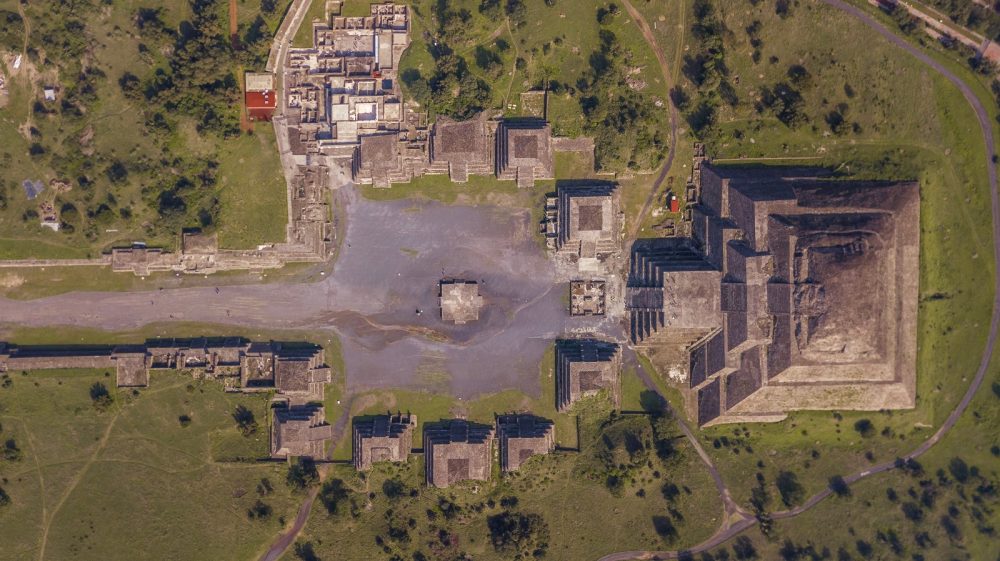
What was sealed off thousands of years ago was meant to remain forever. That thought alone was enough to realize that the secrets inside the sealed chambers were important. In 2004, Gómez and dozens of other archaeologists scanned the area with ground-penetrating radar. The scan revealed a massive tunnel going hundreds of meters into the center of the Pyramid of the Plumed Serpent.
The sinkhole that opened up in 2003 was not the actual entrance but a part of the weaker tunnel than the rest. The sinkhole would eventually reveal one of the most fascinating discoveries of Teotihuacan. With the help of remotely controlled vehicles, a workforce, and a lot of patience, archaeologists discovered three chambers past the sealed off parts of the tunnels.
Inside, archaeologists found countless artifacts, including intricately carved jade statues, the remains of cats, jaguars, as well as spheres. But in addition to that, the archaeologists found traces of liquid mercury beneath the pyramid. This was a huge discovery, hinting at the possible existence of royal burial chambers. As noted by Gómez, the liquid mercury was most likely deposited there thousands of years ago and represented an underworld river.
Speaking to Reuters in 2015, Gomez explained: “The Tunnel is the metaphorical representation of the conception of the underworld.” The builder of Teotihuacan most likely created liquid mercury by heating mercury ore. Liquid mercury was used to decorate several objects as well as the bodies of royalty.
This was not the first time mercury was found in ancient Mesoamerican sites. Previously, archaeologists found traces of mercury at two Maya and one Olmec places. However, the amount of liquid mercury found beneath the Pyramid of the Feathered Serpent is far more extensive than in any other site.
It has been argued that the ancients used pyrite powder in combination with liquid mercury to recreate the mythical underworld, and the chambers and tunnels were most likely used for ritual purposes. The archaeologists discovered thousands of spheres covered in pyrite powder inside the tunnels beneath the Feathered Serpent’s Pyramid.
In 2018, excavations beneath Teotihuacan’s Pyramid of the Moon revealed another chamber and underground tunnels. These were thought to have been used in ancient times for various rituals deeply connected to the underworld. The chamber was found to measure 15 meters in diameter. The tunnel leads towards the Plaza de la Luna, 8 meters beneath Teotihuacan’s second-largest Pyramid.
The find of 2018 follows a series of previous discoveries, some of which date back to the 1980s when archaeologists Rubén Cabrera and Saburo Sugiyama recovered skeletons of elongated skulls, as well as obsidian statues, necklaces, and intricately carved anthropomorphic figurines in tunnels located under the pyramid. Even though no burial chamber was found beneath the pyramid, archaeologists say that the discovery reinforces the idea that the numerous tunnels, chambers, and cavities were used in ancient times for ritual purposes.
What secrets will Teotihuacan reveal in the near future? We can only wait and see as experts continue exploring and excavating one of the largest and most populated cities of antiquity.
Join the discussion and participate in awesome giveaways in our mobile Telegram group. Join Curiosmos on Telegram Today. t.me/Curiosmos

